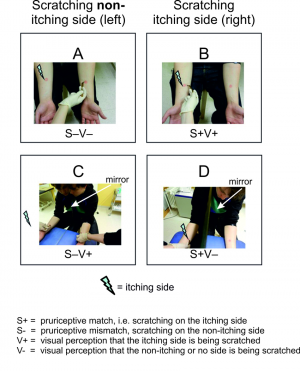Design of the mirror experiment. Credit: doi:10.1371/journal.pone.0082756.g001
(Medical Xpress)—A study of mirrors and the tricks they can play on the mind has led to a finding that people scratching a mirror image of an arm instead of the one that truly itches, can provide some relief. In their paper published in the journal PLUS ONE, the research team from the University of Luebeck, in Germany, describes experiments they conducted with volunteers that showed that the mind can be fooled by even the simplest of mirror tricks.
Building on other experiments that have shown that the use of mirrors can cause strange behavior in people, the researchers set out to discover if it might apply to itching sensations as well. They enlisted the assistance of 26 healthy male volunteers who agreed to participate in their study. All of the volunteers were injected on the underside of their forearms with a chemical known to cause a certain amount of itching. It also causes a small red bump to appear. Each of the volunteers had a similar looking dot printed in the same location on their other arm.
The experiment consisted of scratching each of the volunteers individually on the actual injection site and on the site of the non-injected red mark on the other arm, and querying them as to whether the scratching provided any relief. None of the volunteers reported receiving any relief from the scratching on the non-injected arm and all reported relief from scratching on the read injection site.
Next, all of the volunteers were placed individually in a position with a mirror between their arms—the arm with the chemical injection was hidden from view—the refection of the other arm took its place. Once in place, the volunteers were asked to focus their attention on the red dot on their arm—the one drawn there by the researchers—as the researchers once again scratched both of the red marks. After this second go-round, all of the volunteers reported some degree of relief from the itching when the non-injected spot was scratched, and also, of course when the real site was scratched, despite it being out of their view.
The amount of relief felt on the non-injected site wasn't equal to the real site, of course—all told it amounted to approximately 25 percent of the real deal, but that was far more than when the volunteers were able to see what was going on. This indicates, the researchers claim, that visual cues can oftentimes override information from other senses when there is conflicting information.
More information: Helmchen C, Palzer C, Münte TF, Anders S, Sprenger A (2013) Itch Relief by Mirror Scratching. A Psychophysical Study. PLoS ONE 8(12): e82756. DOI: 10.1371/journal.pone.0082756
Abstract
Objective
The goal of this study was to test whether central mechanisms of scratching-induced itch attenuation can be activated by scratching the limb contralateral to the itching limb when the participant is made to visually perceive the non-itching limb as the itching limb by means of mirror images.
Methods
Healthy participants were asked to assess the intensity of an experimentally induced itch at their right forearm while they observed externally guided scratch movements either at their right (itching) or left (non-itching) forearm which were either mirrored or not mirrored. In the first experiment, a mirror placed between the participant's forearms was used to create the visual illusion that the participant's itching (right) forearm was being scratched while in fact the non-itching (left) forearm was scratched. To control visibility of the left (non-mirrored) forearm, a second experiment was performed in which unflipped and flipped real-time video displays of the participant's forearms were used to create experimental conditions in which the participant visually perceived scratching either on one forearm only, on both forearms, or no scratching at all.
Results
In both experiments, scratching the non-itching limb attenuated perceived itch intensity significantly and selectively in the mirror condition, i.e., when the non-itching forearm was visually perceived as the itching limb.
Discussion
These data provide evidence that the visual illusion that an itching limb is being scratched while in fact the non-itching limb contralateral to the itching limb is scratched, can lead to significant itch relief. This effect might be due to a transient illusionary intersensory perceptual congruency of visual, tactile and pruriceptive signals. "Mirror scratching" might provide an alternative treatment to reduce itch perception in focal skin diseases with persistent pruritus without causing additional harm to the affected skin and might therefore have significant clinical impact.
Journal information: PLoS ONE
© 2014 Phys.org






















